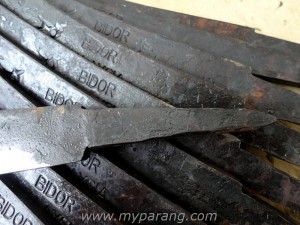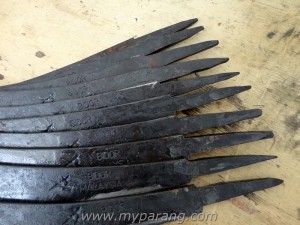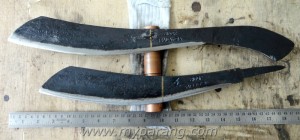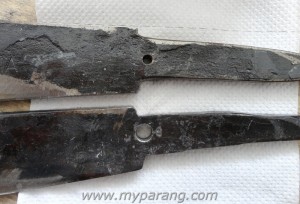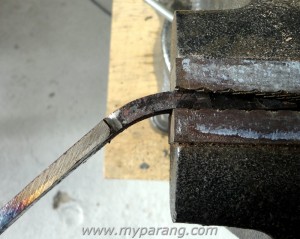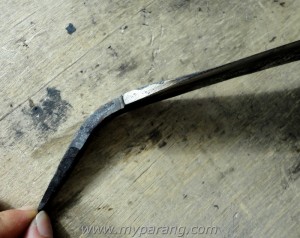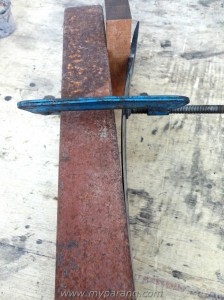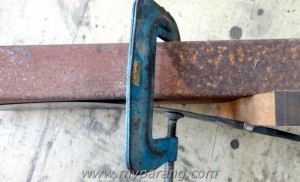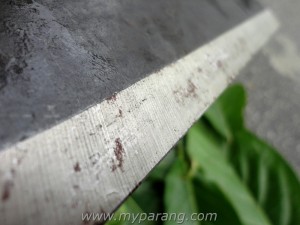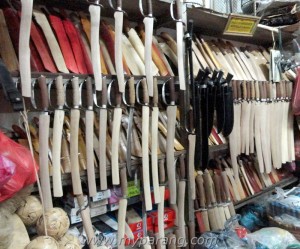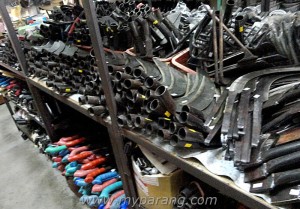
Currently MY Parang products consists two types of parangs – the Duku Chandong and the Golok. The Duku Chandong comes in three variations – the 12 inch, the 10 inch and the 12 inch heavy . As for the Golok, they come in two variations – the 125 and the 135. Below we look at them more closely , in fact this post will be more pictures than words. Enjoy!
General overview of MY Parang Products



The blade which is made of 5160 high carbon steel or commonly know as leaf spring steel and has real forge marks not those fake machine stamped one you see in other commercial brands. The blades are hand forged and each one is unique.
 The handle is made of Eco – wood sourced from Croatia. They are farmed Beech wood and are a renewable resource. The handle shape is of a simple and traditional design . It has been proven to be a very comfortable handle and will not give you any blisters despite chopping away for hours.
The handle is made of Eco – wood sourced from Croatia. They are farmed Beech wood and are a renewable resource. The handle shape is of a simple and traditional design . It has been proven to be a very comfortable handle and will not give you any blisters despite chopping away for hours.


We have made the handle slightly longer to accommodate large hands. The handle design enables various grips comfortably , from choking up to the blade, to holding the handle way back . Various handle position enables different cutting tasks. Unlike some modern parangs, their handle has guards and choils which hinder this natural use of the handle.



Another great feature of MY Parang products is that all the blades has a distal taper. This improves the balance of the parang, making it very lively and quick in the hand, without sacrificing chopping power. A distal taper is very difficult and expensive to achieve with a factory made knife. The spines are also all cleaned up and feature a brush finish. Striking a ferro rod with the spine should not be a problem.

The copper ring / bolster is aesthetically appealing and compliments the whole look of the parang. It serves a beautiful and functional way of transition between the handle and blade. Besides looks, it also serves to strengthen the front of the handle, where most of the shock happens during chopping. Under the copper bolster we have also inserted a brass pin across the handle and stick tang. This is to ensure that the blade will never some out in any circumstances. You will have to brake the handle to cause the blade to come out , something which we believe would be impossible with normal use.
 Most if not all genuine parangs have an unsharpened blade section a few inches after the handle. This is to enable the hand to choke up further into the blade for more delicate cutting tasks. This feature can also be seen on the Duku Chandong.
Most if not all genuine parangs have an unsharpened blade section a few inches after the handle. This is to enable the hand to choke up further into the blade for more delicate cutting tasks. This feature can also be seen on the Duku Chandong.

To securely fasten the tang, handle and Copper bolster, we use industrial strength two part epoxy. We do not skimp on this as it is one of the most crucial parts of the parang. We have seen newspaper , hot glue, molten plastic , superglue and many other suspect ways of holding the tang in the handle, but nothing beats an epoxy specially formulated to bond wood and steel.
MY Parang Duku Chandong
The Duku Chandong or sometimes referred to as the ” Ray Mears ” parang originates from East Malaysia or as some people call, Borneo. It is a very common blade shape there . The Duku Chandong is a general purpose parang and it is very common to see people in Borneo using it in their everyday lives.

The main character of the knife is the sheeps-foot tip and how the handle is lifted up . While the sheeps-foot tip is very strong and suitable for prying, the upward handle causes the blade to arrive first followed by the knuckles. This is a great feature if you are cutting near the ground or near a solid object such as a big tree trunk , as it keeps your knuckles away and prevents if from getting bashed.
The blade also has a slightly upward curve, which produces a slicing cut. This type of cut is very effective at cutting small plants and shrubs.
MY Parang produces three different variations of the Chandong, the 12″ , the 10″ and the 12″ Heavy. The 12″ is the most common size and is often referred to as the ” go to” size. It offers good reach while not being too long nor too short. if you are looking for the best all rounder tool, this is the one to pick. The 10″ version is lighter and shorter. It is best suited for small tasks or when weight is a major issue. Despite it’s small size, it can still chop extremely well. As for the 12″ Heavy version, it is aimed more to those who will be using it to chop more than other tasks. Being made of thicker steel, the overall weight is considerably more and therefore is a beast at chopping. Heavy parangs do have a down side though, one is their overall weight and second, your arms get tired faster when using it. If you are going to use the parang throughout the day, we strongly get the 12″ version.


The above picture shows the spine thickness difference between the 12″ Duku Chandong vs the 12″ Duku Chandong heavy. You can clearly see the difference in spine thickness as well as the distal taper .
MY Parang Golok

While the Chandong is common in East Malaysia , the Golok is a very common design in West Malaysia. Goloks can be seen commonly sold in hardware and certain convenience stores throughout Peninsular Malaysia. It is common to have a golok or two at home, especially if you live in the suburbs. They are general use tools , from skinning animals to cutting weeds to opening coconuts.

Goloks can be characterized by the pointed tip as can be seen above. The tip is pretty strong and the point makes it easy to dig and pry holes. Due to the shape of the tip, it is not really suitable to chop with it, compared to the sheeps foot tip. Goloks also have a prominent belly which can sometimes be a problem with sharpening, especially if your sharpening stone is wide. The belly
The larger Golok, the 135 is a heftier parang which is more suitable for chopping and rough work. The smaller 125 is suitable for lighter work and is considerably shorter and lighter. We have no idea what the 135 and 125 mean, but they seem to be a universal “model” throughout Malaysia , ie a 125 golok bought in different states will be the same design and same length / weight.


